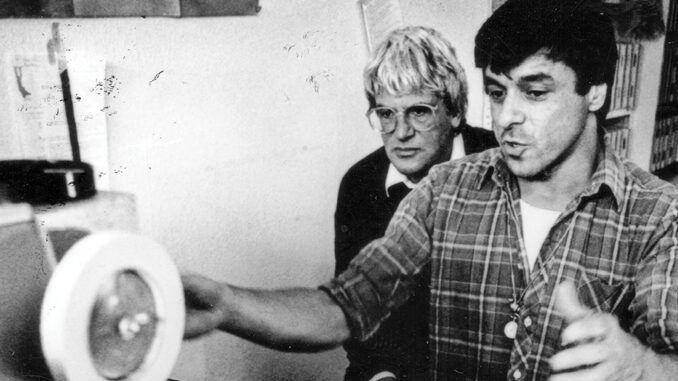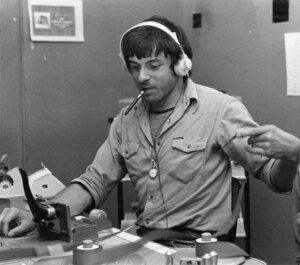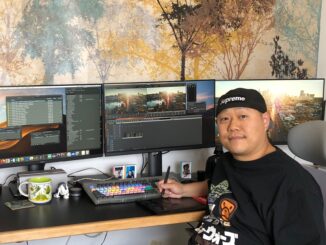
by Edgar Burcksen, A.C.E.
In 1970, as an apprentice in the cutting room of Richard Marden, editor of Sunday Bloody Sunday, we were a happy bunch; Dick, two assistants and myself. Now, as a motion picture editor, I’m mostly by myself, only sharing occasional intense sessions with the director and/or producer.
Assistant editors have disappeared or are shared commodities, and apprentices are completely gone — replaced by what is now called a union contract-evading post-production assistant. As electronics started to replace film and, subsequently, tape gave way to digital, we as editors were so enamored by the expanded creative possibilities of our new devices that we failed to notice how all the human activity slowly faded away from around us.
Ever since editing was accidentally discovered when someone started to glue together two film reels — just like any other manufacturing that happened in the era of the industrial revolution — the work was divvied up in highly specialized jobs that, in the end, delivered a pretty sophisticated product. When you look at all the manpower that went into making regular films, even if you don’t count what went on in front of the camera, it could easily run into the hundreds for 10 reels of a 90-minute final product.
The improvements that the mechanical process of filmmaking was able to implement in the 20th century were rather minimal; in the cutting rooms, they went from writing ink numbers on the edge of the film to working on numbering machines and hot splicers that caused you to lose a frame with each cut to the clear tape splicers. It eliminated just a few jobs.
But when we sat ourselves down behind the monitors of computers and the mechanical era finally ended, scores of people who populated our cutting rooms vanished. However, it did not end there.

The Editors Guild has always been very keen on keeping its membership informed about the latest technological innovations. Earlier this year, I attended an educational session at the Guild offices about Adobe Premiere Pro, presented by Adobe master trainer Christine Steele. I had just started to use Adobe Premiere Pro — the natural heir of all disgruntled Final Cut Pro editors — on a short project and was impressed by the versatility of the software.
A couple of weeks later, I went to the Adobe headquarters in San Jose, California, to attend a preview of its new offerings to be released at NAB 2013. It was a very in-depth and intense personal presentation that showed Adobe’s new solutions for motion picture processing and the improvements on its existing software like Premiere Pro and After Effects.
When I was trying to absorb all these new tools and gadgets, I remembered one thing Steele had mentioned during her presentation at the Editors Guild: Adobe’s CS6 (Creative Suite 6) bundles Premiere Pro, After Effects, Photoshop and all kinds of ancillary software like Prelude, Audition, Media Encoder and more in one powerful package with the clear intention to make the device on which we work the one-stop shop for post-production.
The three-way color-timing tool in Premiere Pro is as powerful as DaVinci, and After Effects has become the prime animation and visual effects tool with seamless connections to 3D software like MAXON. Also, Adobe’s Audition rivals the capabilities of Pro Tools. With these tools and the ability to ingest and export from one format to almost any other format, our cutting rooms seem to be becoming the center of the post-production universe.
When I interviewed my colleague Pietro Scalia, A.C.E., about Gladiator for the Spring 2001 issue of the American Cinema Editors magazine, CinemaEditor, he mentioned something that I had not realized before: Our job as editors was the only true new art form that
was created when motion pictures came into being. Acting, directing, production design, photography and sound all existed in some form before the Lumière brothers invented moving pictures.
So it is not at all surprising that the unique and long underappreciated art form of film editing quietly and unassumingly became the essence of what motion pictures stand for. As editors (mostly under the radar without any glamour) perfected the art of film editing in cramped quarters with noisy machines, motion pictures in many formats became a staple of entertainment and information in modern life — first with film, then TV and now in the many iterations of the Internet.
When my editorial creativity was boxed in between film, grease pencil and two tracks of sound on my flatbed, the introduction of electronic — and later digital — editing freed me up in many ways to manipulate my images and sounds to what I needed
to do my job as a storyteller. But without my noticing it, this freedom slowly has turned into an unexpected burden. I had not realized that expanded creativity also meant more work; even though I seemingly could tell a story much faster without the complicated editorial infrastructure of film, the time I spent on completing a production stayed basically the same.
However, what I delivered to the director and producer as locked picture was much more elaborate with opticals, titles, visual effects, dialogue, sound effects, ambiances and temp music tracks. Although all this work was still not the final product, it was a template of what other professionals after me would have to do to make it the final product. But when you’re perfecting your picture edit with all these extra tools, you’re actually doing the work that somebody else was doing before this was possible. The result is that this somebody now has no job or does another job.

In this respect, the film business, and especially the post-production side of it, is no different than other branches of manufacturing: The advances in technology eliminate labor and concentrate the remainder to increase productivity per capita. You cannot stop technology, and the increased productivity per capita has eliminated some tedious and dumb work. Believe me, nobody wants to go back to rewinding reels of film or filing trims from bins into boxes.
However, there comes a moment when technological advances no longer streamline a workflow, but start to infringe on the integrity of the work itself. When our workstations become the central point of where captured imagery and sound are ingested and transformed into the final product that, after duplication, is distributed on available platforms, then we need to reassess what our job as editor actually entails.
Even though I re-frame, flip and zoom shots, I’m not a cinematographer; when I use the keyer on my Avid, Final Cut or Premiere Pro, I’m not claiming to be a visual effects artist; using the title tool and After Effects does not make me a graphic designer; adjusting the color of a shot to fit a scene will not turn me into a colorist; adjusting the EQ or level on a dialogue track is not transforming me into a re-recording mixer; adding sound effects and ambiances does not elevate me to a sound designer; and, by adding a temp track of music, I’m not becoming a composer.
Nonetheless, all of these tasks you now are expected to perform as a competent editor, especially in productions with a “challenged” budget. Underlining this trend, Alan Heim, A.C.E., told me that when he delivered a first cut for a screening, he was asked why the Foley was missing.
The Editors Guild has done an exemplary job in coping with the changing times by absorbing a lot of the fractured locals in the post-production arena to become the union that almost entirely covers the whole post-production field. From this position, we as union members have the responsibility to look into the future and try to redefine the jobs in post-production based on the ever-evolving technology. We cannot expect the software designers, engineers and programmers to limit themselves to improving the tools with which we work by contemplating who and how their digital solutions will be used.
I consider myself a storyteller, but I have a hard time determining whether the tools that I use improve my capabilities or start to infringe on the work better done by other professionals. We need to start a discussion about the distribution of the workload of post-production, about where my job ends and another one starts. If we are not proactive in this matter, it will be decided for us — and we will have to live with the consequences.





